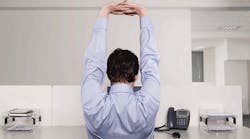Over the years, I've developed work habits that are – frankly – very bad habits. My posture is terrible; my workstation is cluttered and the lighting is terrible; I forget to eat; I forget to blink; my lunch often consists of snack foods from the vending machine; I forget to get outside for a quick lunchtime walk on beautiful days… And I'm not alone.
"It's not that we're bad people, or that we aren't working hard," says Leigh Stringer, LEED AP, author of The Healthy Workplace (www.leighstringer.com). "The problem is that what our minds and bodies need at a basic level is in conflict with our work style. We are so focused on work on getting things done, that we've changed the way we eat, move and sleep in a way that is actually counter-productive."
Stringer works for EYP, an architecture, engineering and building technology firm and is a workplace strategy expert and researcher. Her work has been covered by CNN, USA Today, The Wall Street Journal and Good Morning America.
She offers these 10 tips for creating a healthy workplace. Some are steps we can take as workers; some are suggestions for management.
- Build flexibility into how, when and where you work. Studies show that people who feel more "in control" of their work and work environment are less likely to suffer from stress and illness and see increases in productivity. Also, change "how" you work: Move more and take a look at how you work and explore alternatives to sitting in one position all day.
- Nurture "biophilia." Place small plants or a water feature on your desk or nearby. These elements are soothing psychologically and reduce stress. Even pictures of trees and water can have the same biophilic impact as the real thing.
- Reduce the number of unhealthy foods to improve eating habits. Work with your local food service provider or local restaurants to provide healthy options for meetings and events.
- Make getting healthy a team sport. Create competitions between teams or different office locations to encourage more walking, biking or participating in team sports over the course of a work week.
- Create healthy "nudges" to take the stairs such as painting the stairwell a lighter color so that it appears brighter and less foreboding and adding artwork to give it a personal touch and add visual interest. And if your building is like mine and you can't take the stairs, take a walk at lunch instead.
- Remove distracting behaviors in the workplace. Be conscious of coworkers when using speaker phones or holding meetings in open areas.
- Stay home when you are sick. ‘Nuff said.
- Be conscious of lighting. Unfortunately for most of us, we spend 90 percent of our day indoors, which plays havoc with our sleep cycle. Try screwing a "daylight" LED bulb into your office task light. You will be shocked by how much better you feel after just a few minutes of use, and you will likely sleep better at night.
- Bring your pet to work. A growing body of evidence suggests that pets in the office can have health benefits, improve morale and even increase collaboration among workers. (I swear this is one of Stringer's suggestions; I'm not making it up!)
- Lead by example. Adopt healthy changes in your life that will give you the knowledge you need as a leader to convince others to change. Eat better and bring in good, healthy foods to share with your team when appropriate. Integrate movement into your day by organizing a stand-up meeting, walking while you take a conference call or trying out an "exercise desk."
"Studies show that unhealthy work habits, like staring at computer screens and rushing through fast-food lunches are taking their toll in the form of increased absenteeism, lost productivity and higher insurance costs," says Stringer, "but it doesn't have to be that way."

